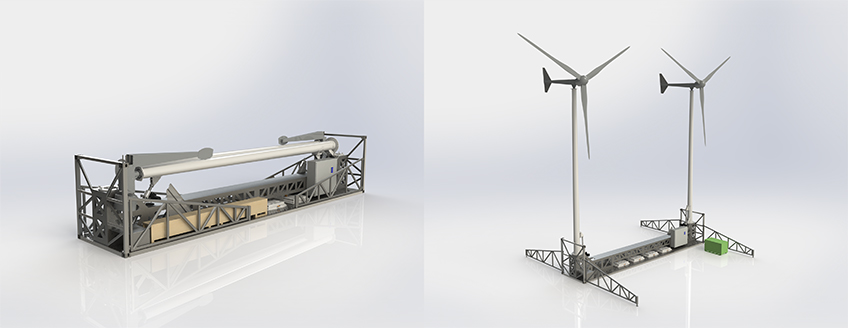D3T: Defense and Disaster Deployable Turbine Project
The D3T research partnership developed potential portable and rapidly deployable wind energy systems to power national defense and disaster recovery missions.

Providing quick access to energy during national defense and disaster recovery could look like this rapidly deployable wind energy system. Shown on the left is the system in its shipping configuration and on the right as it would be deployed on location. Illustrations from Mike Bergey, Bergey Windpower Co.
Fast access to energy on location is critical to ensuring a successful military or humanitarian response when conflicts and natural disasters occur. These missions currently depend on reliable access to liquid fuel that could be vulnerable to disruption or attack during transport. Generating power on location—whether at a contingency base or disaster response coordination point—can reduce this risk and enhance mission reach by diversifying energy sources.
The U.S. Department of Energy's D3T project—a collaboration among NLR, Sandia National Laboratories (project lead), and Idaho National Laboratory—aimed to meet the unique energy needs of defense operations and responses to humanitarian crises. Read the U.S. Department of Energy's Defense and Disaster Deployable Turbine fact sheet.
The multilab D3T project concluded in September 2022, but for technology developers, disaster response organizations, and the defense industry, the work continues. The D3T project team held a virtual workshop for stakeholders on June 17, 2022. On Sandia National Laboratories' D3T site, you'll find more information on the workshop report, the study's benefits reports, and deployable wind energy design guidelines. Refer to the NLR news article, How Wind Turbines Could Power Defense and Disaster Relief, to learn about the project's 4 years of activity.
Primary Research Activities
Natural disasters and human conflicts can occur anywhere in the world—and not always in locations with high-quality wind resources. Moreover, the operations responding to these events are typically temporary, lasting a few weeks to a few years. Existing wind turbine products are rarely optimized for these circumstances.
Through D3T, NLR worked with military and wind energy industry personnel to use information gathered from prior studies, direct interviews, and modeling and simulation tools to:
- Evaluate the market potential for rapidly deployable wind energy technologies
- Assess commercially available wind technologies against operational needs
- Define general design specifications for one or more deployable wind applications
- Identify technology gaps and research and development opportunities.
This information can then be used to guide investments in research, development, and validation of new wind technology solutions that:
- Deploy rapidly
- Provide quick access to energy
- Reduce risk by diversifying energy sources
- Help ensure successful response during times of crisis.
Collaboration
The D3T project facilitated technical discussions among the wind industry, the U.S. Department of Defense, and other federal agency stakeholders to define energy needs and identify rapidly deployable wind energy technology solutions.
Contact us for more information on:
- Design guidelines for deployable wind concepts, prototypes, and commercial products for defense or disaster response applications
- Opportunities to develop optimal deployable wind turbine systems from research and development through testing and evaluation as well as fielding systems in an operational environment.
Contact
Share
Last Updated Dec. 6, 2025
